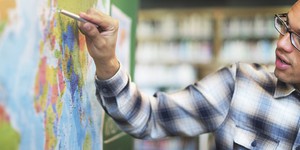Log In
Summary
*Note:
For this science project you will need to develop your own experimental procedure. Use the information in the summary tab as a starting place. If you would like to discuss your ideas or need help troubleshooting, use the Ask An Expert forum. Our Experts won't do the work for you, but they will make suggestions and offer guidance if you come to them with specific questions.
If you want a Project Idea with full instructions, please pick one without an asterisk (*) at the end of the title.
If you want a Project Idea with full instructions, please pick one without an asterisk (*) at the end of the title.
Abstract
How is geology important for our energy resources? Coal, oil, and natural gas are formed by geological processes over millions of years. Certain geological formations can indicate a reservoir of coal, oil, or natural gas. Also, geothermal processes can be used as an energy resource. How are these formations identified? How are the resources extracted? You can use the National Geospatial Program to access, view, and download information from geospatial databases containing a broad spectrum of data produced by the USGS and other government agencies. You can also visit the USGS Energy Resources Program to get data on national and global resource assessments for coal, oil, and natural gas reserves. Where are these resources located? How are they distributed among the continents? Compare this data to a topographic or relief map. Are these resources generally located near certain geological features?Bibliography
- United States Geological Survey (USGS). (2013, January 16). National Geospatial Program. U.S. Department of the Interior. Retrieved March 18, 2013.
- United States Geological Survey (USGS). (2012, Oct. 5). Energy Resources Program. U.S. Department of the Interior. Retrieved March 8, 2013.
- National Geographic Education Beta. (n.d.). (n.d.). Natural gas. Retrieved March 8, 2013.
Ask an Expert
Do you have specific questions about your science project? Our team of volunteer scientists can help. Our Experts won't do the work for you, but they will make suggestions, offer guidance, and help you troubleshoot.
Global Connections
The United Nations Sustainable Development Goals (UNSDGs) are a blueprint to achieve a better and more sustainable future for all.
This project explores topics key to Affordable and Clean Energy: Ensure access to affordable, reliable, sustainable and modern energy.
Careers
If you like this project, you might enjoy exploring these related careers:
Career Profile
When you hear the word geography, you might think of maps and names of state capitals, but the work of geographers is much more than creating maps and identifying places. Geographers look at how people, places, and Earth are connected. They study the economy, social conditions, climate, and topography of a region to help answer questions in urban and regional planning, business, agriculture, and medicine.
Read more
Career Profile
Just as a doctor uses tools and techniques, like X-rays and stethoscopes, to look inside the human body, geoscientists explore deep inside a much bigger patient—planet Earth. Geoscientists seek to better understand our planet, and to discover natural resources, like water, minerals, and petroleum oil, which are used in everything from shoes, fabrics, roads, roofs, and lotions to fertilizers, food packaging, ink, and CD's. The work of geoscientists affects everyone and everything.
Read more
Career Profile
Have you ever climbed up high in a tree and then looked at your surroundings? You can learn a lot about your neighborhood by looking down on it. You can see who has a garden, who has a pool, who needs to water their plants, and how your neighbors live. Remote sensing scientists or technologists do a similar thing, except on a larger scale. These professionals apply the principles and methods of remote sensing (using sensors) to analyze data and solve regional, national, and global problems in…
Read more
Career Profile
Have you ever been in a new city and needed to figure out how to get from point A to point B? Have you ever tried to figure out the best time of the year to go on vacation so that you have good weather? Many people in these situations turn to a map. Maps are important sources of information, and geographic information systems (GIS) technicians are the professionals who gather data from a variety of sources, store it in databases, and use those databases to make accurate maps. Because maps are…
Read more
Related Links
Cite This Page
General citation information is provided here. Be sure to check the formatting, including capitalization, for the method you are using and update your citation, as needed.MLA Style
Science Buddies Staff.
"Geology and Energy Resources." Science Buddies,
23 June 2020,
https://www.sciencebuddies.org/science-fair-projects/project-ideas/Geo_p025/geology/energy?class=AQVDYE-VTF0Hm_D6TtMqVYFraPEHo226lPGUME5JXFxoLwQoxjGV8_XwW-x2QS7cZ2GAgAi9VdEdcTHgHn3NNehxkWacKArSiI598u44Xcn_BQ.
Accessed 23 Apr. 2024.
APA Style
Science Buddies Staff.
(2020, June 23).
Geology and Energy Resources.
Retrieved from
https://www.sciencebuddies.org/science-fair-projects/project-ideas/Geo_p025/geology/energy?class=AQVDYE-VTF0Hm_D6TtMqVYFraPEHo226lPGUME5JXFxoLwQoxjGV8_XwW-x2QS7cZ2GAgAi9VdEdcTHgHn3NNehxkWacKArSiI598u44Xcn_BQ
Last edit date: 2020-06-23
Explore Our Science Videos
Build a Machine to Lift Water - STEM Lesson Plan
How to Build a Toy Car - Science Project
How Far Can a Sneeze Go?











